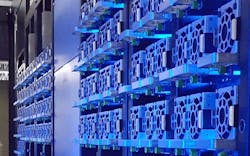Understanding the Differences Between 5 Common Types of Data Centers
1. Enterprise Data Centers
An enterprise data center is a private data center facility that supports a single organization. These types of data centers are best suited for companies that have unique network needs—or companies that do enough business to take advantage of economies of scale. Enterprise data centers are custom built to be compatible with the organization’s distinctive enterprise apps and processes.
You’ll find these data centers located either on the same site as the organization (an on-premises location) or off-premises at a site chosen for the connectivity, power and security it offers. For example: A company may choose to separate business operations from data center operations in case of a disaster. Or, as another example, it may build its data center in a colder climate to reduce energy use.
In either case, the in-house IT department typically manages the white space (IT equipment and infrastructure). The gray space (back-end data center components and equipment) may be outsourced or managed by the internal facilities management team in conjunction with IT.
2. Multi-Tenant Data Centers/Colocation Data Centers
Multi-tenant data centers (also known as colocation data centers) offer data center space to businesses that want to host their computing hardware and servers offsite. These facilities provide the proper data center components—power, cooling, security and networking equipment—needed to do so.
Companies that don’t have the space for their own enterprise data center—or an IT team to dedicate to managing one—often choose a colocation data center. This allows them to redirect financial and personnel resources to other initiatives.
An organization can lease the amount of space they need to host their data and, as their needs change, they can quickly scale up or down. All types of industries take advantage of multi-tenant data centers, from healthcare and banking to manufacturing and government agencies.
The demand placed on these types of facilities is intense. Clients expect constant uptime, ample bandwidth capacity and the ability to access data quickly and at a moment’s notice. To keep up with these increasing pressures, multi-tenant data centers often refresh their hardware and technology more frequently than an enterprise data center.
3. Hyperscale Data Centers
Hyperscale data centers are designed to support very large-scale IT infrastructure. According to Synergy Research Group, there are only 700 hyperscale data centers in existence—but that’s twice as many as five years ago. While this may be a small percentage compared to the number of data centers across the globe (there are more than 7 million data centers worldwide), hyperscale data centers are on the rise. Interesting fact: Amazon, Microsoft and Google account for more than half of all hyperscale data centers.
Like enterprise data centers, hyperscale data centers are owned and operated by the company they support—just on a much larger scale for cloud computing platforms and big data storage. A typical hyperscale data center has at least 5,000 servers, 500 cabinets and 10,000 square feet of floor space.
4. Edge/Micro Data Centers
The demand for instantaneous connectivity, expansion of IoT and need for analytics and automation are driving the growth of edge solutions so computing occurs closer to the actual data.
These types of data centers are small and located near the people they serve to handle real-time data processing, analysis and action, making low-latency communication with smart devices possible. By processing data services as close to end users as possible, edge data centers allow organizations to reduce communication delay and improve the customer experience.
As innovative technologies continue to transform the way we live and work—from robots, telemedicine and 5G to autonomous vehicles, wearable healthcare technology and smart electrical grids—we’ll continue to see more of these types of data centers emerge.
5. Container/Modular Data Centers
A container data center is usually a module or shipping container that’s packaged with ready-made, plug-and-play data center components: servers, storage, networking gear, UPS, generators, air conditioners, etc.
The concept of a container/modular data center was first introduced only about 15 years ago, and it’s now being used in temporary and permanent deployments. You’ll often find modular data centers on construction sites or in disaster areas (to support alternate care sites during the pandemic, for example). In permanent environments, they’re deployed to free up space inside a building or to allow an organization to scale quickly to accommodate new technology, such as adding IT infrastructure to an education institution to support digital classrooms.
Shad Sechrist is Data Center Pre-Sales Solutions Engineer at Belden. He has more than 20 years of experience in the electrical and electronic manufacturing industry, including data center design, building infrastructure consulting and network design. Learn more about Belden‘s data center components and solutions.

